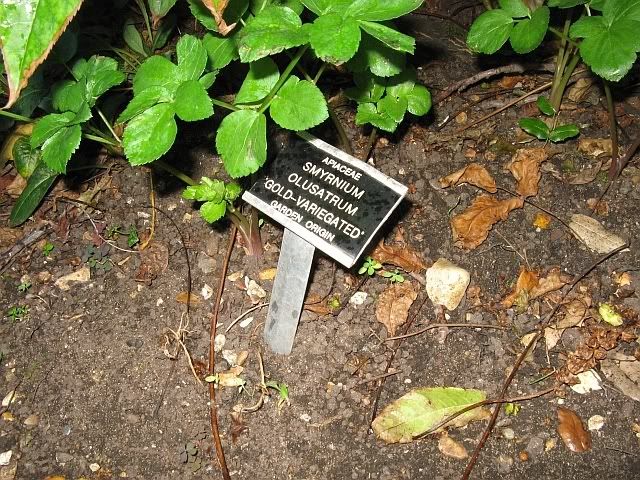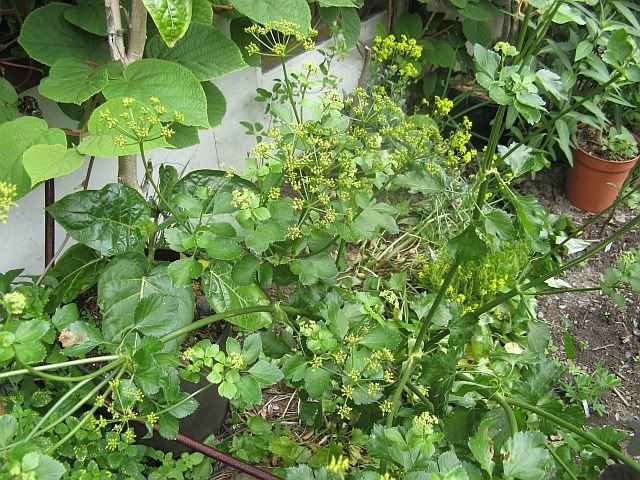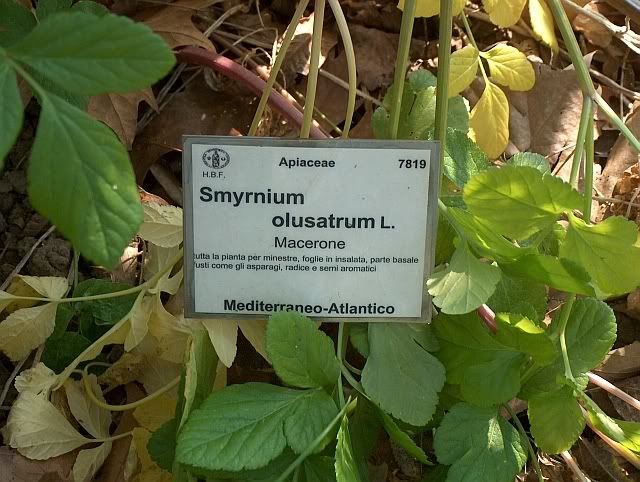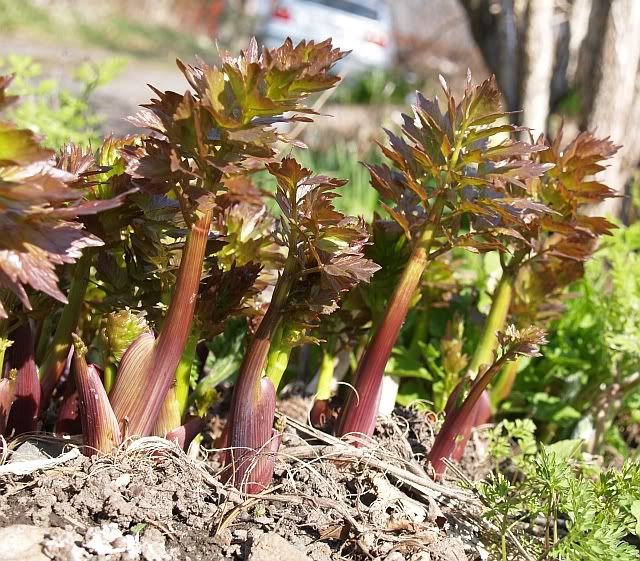|
|
celery
Jan 25, 2009 10:07:48 GMT -5
Post by ottawagardener on Jan 25, 2009 10:07:48 GMT -5
Ah Stephen: you are one of my gardening heros along half the other people here. I hadn't heard of that one before.
I'm too scared to try celery but love celeriac and have gotten it to work this way:
Start really early, like around the time you start peppers
Pray to germination gods and then get too many seedlings so you have to thin ruthlessly
Plant in shallow trenches or if you have raised beds, at the bottom of the rise to make sure it gets lots of water.
It does very well in 4 hours of sun at my house which I think is because of water conservation once again.
The key is a long growing season, like 120 days.
It will survive early fall frosts.
Liberally apply magic potion of unknown ingrediants and pray again to plant gods
In this manner, I've gotten large swollen stems
(I won't mention all the plants that don't grow well for me)
The tops of celeriac can be used like celery but they are really strong tasting. If you forced the roots without light they would probably be better. I like celeraic though because it can be cellared
Lovage, apparently, can be blanched and used like celery and it is perennial too.
How about Alexanders - never tried it but I've heard good things.
At a local garden nearby, they used celeriac as a very pretty decorative border.
|
|
|
|
celery
Jan 26, 2009 11:38:55 GMT -5
Post by bunkie on Jan 26, 2009 11:38:55 GMT -5
a neighbor gave us some Lovage plants many years ago. they were a perennial and came up every year, even after the year hubby ran over them with the tractor. we finally lost them when he was redirecting soil where they were.
i just started some seeds last year and they're sitting in the kitchen windowsill and am planning to start another patch this spring. we really like the taste of Lovage. it is celery-like, but stronger. both the leaves and stalks can be used. not sure about the bulb root, tho. i'm sure it could be blanched, but as we've found with celery, the taste is stronger green.
|
|
|
|
celery
Jan 26, 2009 15:12:53 GMT -5
Post by stevil on Jan 26, 2009 15:12:53 GMT -5
I'm too scared to try celery but love celeriac and have gotten it to work this way: Start really early, like around the time you start peppers Pray to germination gods and then get too many seedlings so you have to thin ruthlessly Plant in shallow trenches or if you have raised beds, at the bottom of the rise to make sure it gets lots of water. It does very well in 4 hours of sun at my house which I think is because of water conservation once again. The key is a long growing season, like 120 days. It will survive early fall frosts. Liberally apply magic potion of unknown ingrediants and pray again to plant gods In this manner, I've gotten large swollen stems Lovage, apparently, can be blanched and used like celery and it is perennial too. How about Alexanders - never tried it but I've heard good things. I think I'm going to have to try Celeriac again  I did everything you tell apart from the last bit: "Liberally apply magic potion of unknown ingrediants and pray again to plant gods" Please send me some of those unknown ingrediants with the seed you're sending and put in a good word for me with the plant gods - I'm not as Evil as my name suggests. Should I change my nick to StGood perhaps? When I think of Alexanders, I think of the White Cliffs of Dover for it's a coastal species in the UK, introduced I think and hailing from even further south in Europe, so not one of the hardiest plants. It also has the disadvantage of dying after flowering. However, I do manage to cultivate it by using a deep mulch of leaves in winter. I find it quite strong tasting and haven't used it that much - I must admit I often forget, it flowers and it's gone for another two years. I'm hoping to try it blanched this year. Being a coastal species I'm growing on my Sea Kale bed with a seaweed mulch this year. However, one of the rarest herbs is the legendary golden variegated Alexanders. The nearest I've got is the following picture, but the plant was not golden or variegated....  A couple of shots from my garden:   ...and some recipes:  ...and thanks to Frank, the pictures now work.... |
|
|
|
celery
Jan 26, 2009 15:26:48 GMT -5
Post by stevil on Jan 26, 2009 15:26:48 GMT -5
a neighbor gave us some Lovage plants many years ago. they were a perennial and came up every year, even after the year hubby ran over them with the tractor. we finally lost them when he was redirecting soil where they were. Yes, it's strong - you don't need many plants! It's best in spring, especially when blanched, but even later in the summer you can usually find some young growth in the middle of the plant. It's a stayer and self-sows into awkward places where it's difficult to dig out. It survives and is common particularly in old gardens here and is one of the few perennials that people quite often use, particuarly in soups.  Traditionally people here would plant it right next to the house as it reputedly scared off snakes. As we don't have snakes here, I have no need for planting it strategically... It was even fed to cows in the spring before they were released into the woods as it would protect them against snake bite. |
|
|
|
celery
Jan 26, 2009 15:39:39 GMT -5
Post by orflo on Jan 26, 2009 15:39:39 GMT -5
Nice pictures, Stephen.  And lovage is amazingly strong,part three... I once had plants up to 2,5 metres and they resowed everywhere. I removed all the seedlings, but I didn't notice there was one in between the stones on the foothpath before the house (or did I notice???  ). And now it's still there, some six or seven years later, sometimes I cut it completely, but it regrows and regrows, and even pushes the stones a bit up. Alexanders is already edible over here, January 26 (even with the cold spell we had), I have plants now that are just about 30 cms wide. But I agree, the taste is strong, the variety grown in Southern Europe should taste less strong, , I believe it's called perfoliate Alexanders, but I never tried it. |
|
|
|
celery
Jan 26, 2009 16:00:21 GMT -5
Post by stevil on Jan 26, 2009 16:00:21 GMT -5
Yes, I've learnt to stop it seeding - it's growing next to Sweet Cicely (Myrrhis) - blurred in the picture above - and this is even more invasive.
I grew perfoliatum one year - I sowed it and planted it out, but it died in the winter. However, it somehow turned up somewhere else in the garden and not being sure of its identity in the spring, I didn't try it (I identified it when it flowered) but it died and no seeds. Although biennial, they tend to take 3 years to flower here.
I've tried a couple of other species too unsuccessfully (there are maybe 20) but I've never heard of others being used for food.
|
|
|
|
celery
Jan 26, 2009 17:18:30 GMT -5
Post by houseodessey on Jan 26, 2009 17:18:30 GMT -5
Mine still has not germinated. This doesn't bode well for my celery growing abilities. I'll try again, though.
|
|
potagere
gopher
 On slopes of the Jura nr Geneva, Switz. Zone 7a/b, but colder microclimate. About 52 sq m in veggies
On slopes of the Jura nr Geneva, Switz. Zone 7a/b, but colder microclimate. About 52 sq m in veggies
Posts: 46
|
celery
Feb 19, 2009 6:22:35 GMT -5
Post by potagere on Feb 19, 2009 6:22:35 GMT -5
I was just thinking I should maybe try celeriac again this year. I've never gotten the swollen roots, just the tops, but even those I like to use in chicken soup. I'm forced to actually BUY celeriac, and I do, because I use it in soups and stews; it is a popular bistro salad with mayonnaise (but better, I think, with light sour cream or yogurt and caraway, cumin or zirah seeds); makes a nice, if rather sweetish puree; works even better half-and-half with potatoes in puree; also makes a lovely gratin with cheese and sour cream (i have to slip the cumin seeds in there, too); also nice in a mixed puree with topinambour (Jerusalem artichokes).
Now, if I could just GROW it! Need some of your magic potion, I guess, ottawagardener!
|
|